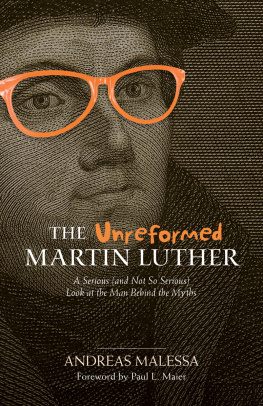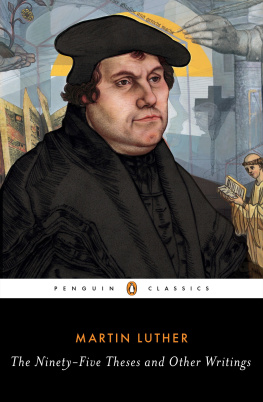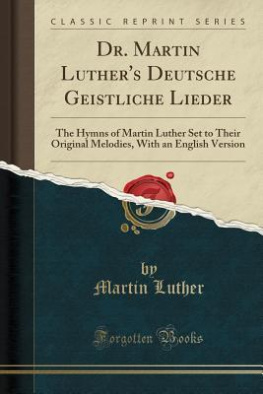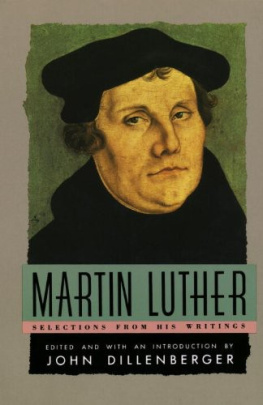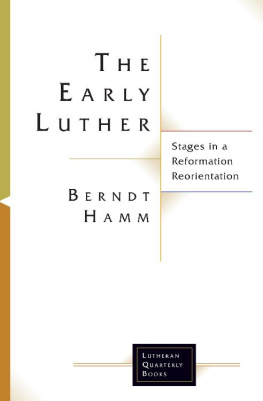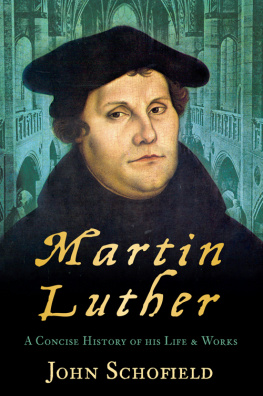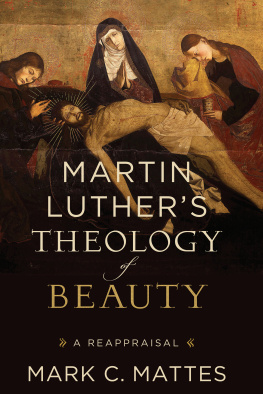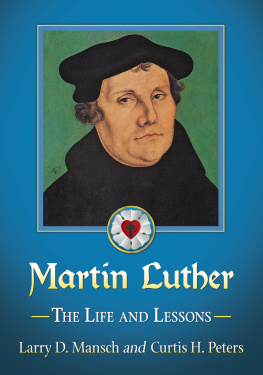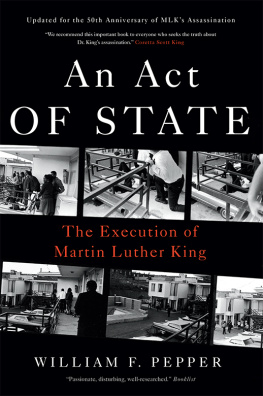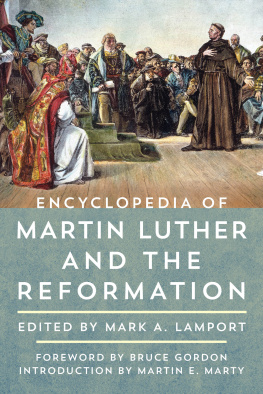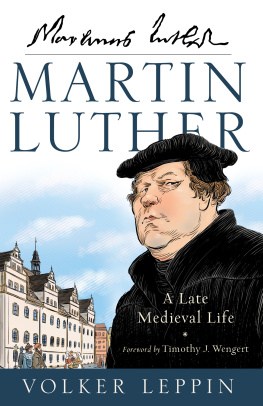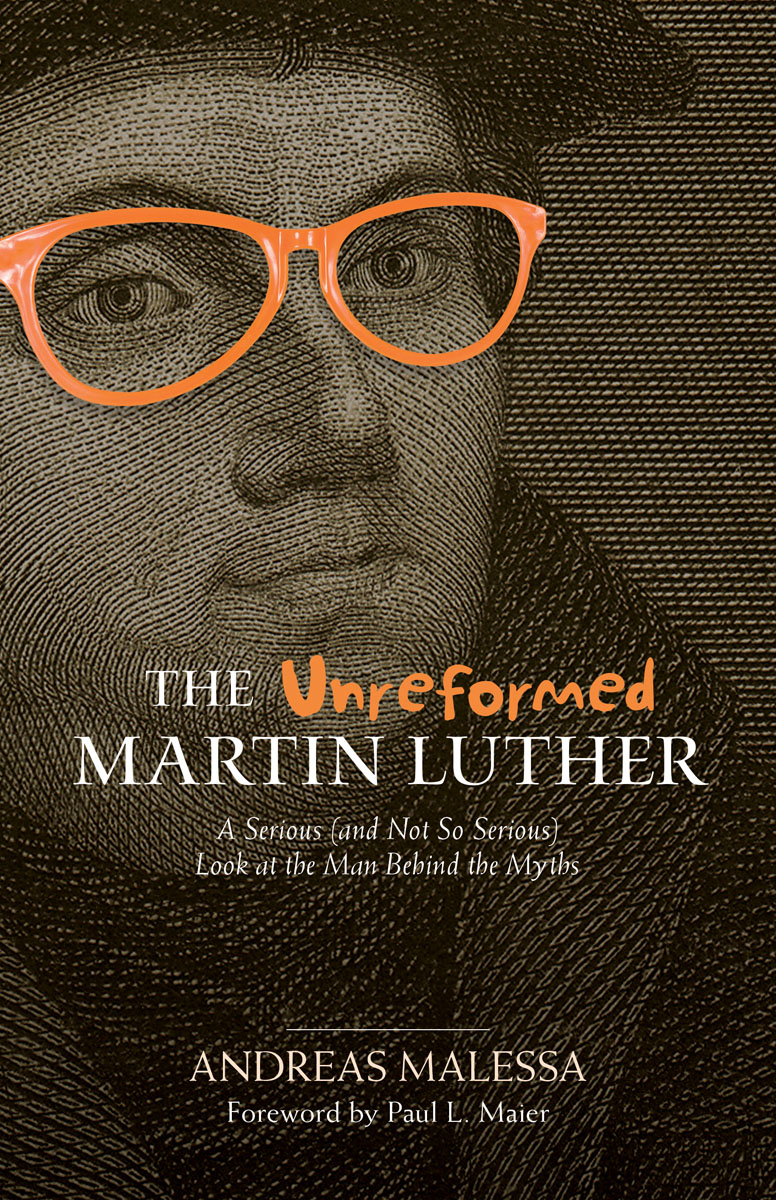
The Unreformed Martin Luther: A Serious (and Not So Serious) Look at the Man Behind the Myths
2017 by Andreas Malessa
Published by Kregel Publications, a division of Kregel, Inc., 2450 Oak Industrial Dr. NE, Grand Rapids, MI 49505.
The original German edition was published as Hier stehe ich, es war ganz anders. Copyright 2015 SCM-Verlag GmbH & Co. KG, Holzgerlingen, Germany (www.scm-haenssler.de).
Translation by Matthew L. Hillman
English adaptation by Dennis R. Hillman
Map of Central Europe in the Time of the Reformation by Erwin Webber. Copyright LutheranReformation.org. Used by permission.
All rights reserved. No part of this book may be reproduced, stored in a retrieval system, or transmitted in any form or by any meanselectronic, mechanical, photocopy, recording, or otherwisewithout written permission of the publisher, except for brief quotations in reviews.
Distribution of digital editions of this book in any format via the Internet or any other means without the publishers written permission or by license agreement is a violation of copyright law and is subject to substantial fines and penalties. Thank you for supporting the authors rights by purchasing only authorized editions.
Scripture quotations are from the Holy Bible, New International Version, NIV. Copyright 1973, 1978, 1984, 2011 by Biblica, Inc.TM Used by permission of Zondervan. All rights reserved worldwide. www.zondervan.com
ISBN 978-0-8254-4456-2
Printed in the United States of America
17 18 19 20 21 22 23 24 25 26 / 5 4 3 2 1
Contents
Foreword
T he greats of history seem to have one thing in common: however dramatic their lives, inevitably legends, myths, and fables are added to the historical record, either by tradition or the intent of biographers. Gnostic authors added ridiculous details to the life of Jesus of Nazareth, much as Parson Weems did centuries later, with more noble intentions, to George Washington.
Martin Luther was no exception. Both friends and foes added unhistorical addenda to the facts of his life. This book by German author Andreas Malessa is a collection of many of the most familiar stories about Luther. Perhaps the most controversial is his claim that when Luther stood before Emperor Charles V, he did not crown his defiant defense with the famous words, Here I stand. I cannot do otherwisesince court reporters did not preserve these words and they are only attested much later. (John Foxe, a younger contemporary of Luther, wrote in his famous Book of Martyrs that Luther closed his defense with the words, Here I stand and rest. May God have mercy on mewhich may lend authenticity to this traditional statement after all.)
Debunkers can certainly be killjoys. But they are necessary to keep truth about the past clear and accurate. These pages are no hostile assault on the life of Luther. On the contrary, they often correct the record on the cruder myths generated by his opponents, such as the claim that Luther was a drunkard, a liar, and even someone who ate at the pulpit while preaching.
Anything but a rehash of Luthers life, this book is immensely readable and well crafted, and will provoke laughter on nearly every pagethanks to Luthers own blazing sense of humor and to the Hillman son-father teams skillful translation and adaptation of the original German edition.
Martin Luthers colorful life story has no need for embellishments of any kind since facts alone qualify his as one of the most dramatic in history. He was The Man of the Second Millennium, a towering figure who changed the world. This embattled ex-monk had to fight on two fronts for the rest of his life: against the medieval Catholic Church on the right, which excommunicated him for daring to reform the church, and the radical revolutionaries on the left, who claimed that Luther had not gone far enough. All the while he accomplished what seemed impossible: tearing down unbiblical traditions but rebuilding the church, thus doing the work of half a dozen theologians. Such a life needs no enhancements whatever. Bravo to Andreas Malessa for identifying the enduring greatness of Luther.
P AUL L. M AIER
Professor (Emeritus) of History
Western Michigan Univerisity
Preface
W hen someone becomes a famous personality, adored by millions of fans and puffed up by the media, they inescapably achieve star status (or at least become a celebrity of sorts). And predictably, as celebration gives way to cynicism, the entertainment press and investigative journalists want to peel back the public mask and reveal the real person. Reporters try to find (or invent) weaknesses, mistakes, and, preferably, scandals. The rule seems to be: First the hype, then the story. So run the daily ups and downs in the entertainment excitement curve.
Historians are already in one sense investigative journalists when it comes to Martin Luther, but the public face of Lutherthe mythic Lutherhas been shaped by many others. In serious, academic tones (like historians)but using methods similar to that of journaliststhe media, the church, and the culture-shapers have created this great historical figure, a Luther gilded in polished gold. That will certainly be the case during this year, the five-hundredth anniversary of the Reformation. The Luther hype will predictably lead a handful of professional historians to say, Well, it was actually totally different.
Im not an investigative journalistand neither do I want to beand although I like church history and theology, thats not where I began my research on Luther. I have asked students and teachers, workers and retirees, friends and colleagues, what they know about Martin Luther and the Reformation. I have come across legends, horror stories, terribly wrong quotes, and, above all, many little half-truths and funny myths. I have noted all of them. And with them and my responses to them, I would like to inform (as well as amuse) you. Yes, and perhaps also shock youthe sixteenth century is not for the faint of heart.
The Weimar edition of Martin Luthers complete works includes all his books, Bible commentaries, sermons, table talks, lectures, essays, leaflets, and records. The Weimar edition is about eighty thousand pages long, bound in 121 volumes. There are 2,585 letters that Luther wrote and 926 letters that were written to him. There are so many texts that one could prove almost anything about Luther as well as furnish the respective counterargument with quotes from his contemporary friends and enemies. Its not hard to find evidence to corroborate the view that Luther was all of these:
the traumatized child and the respectful son
the self-tormenting ascetic and the tippler
the vulgar churl and the sophisticated poet
the affectionate husband and the domineering macho man
the popular speaker and the intellectual genius
The complexity of Luthers personality only increases when other characterizations are considered:
Luther the sly politician
Luther the pious prayer
Luther the free thinker
Luther himself already knew what would happen after his death: Now everyone wants to be heard first and each wants to spill out their thoughts. On this topic the preacher Solomon said rightly, of making many books there is no end! You will still be amazed, when I lie in the ground, how many books will be written about me.
I acknowledge my own guilt in this accusation. So, have I distilled here the real Luther by pulling back the mask and discovering the man beyond the myths? Most likely notat least not completely. But perhaps by the end of this short investigation, you will be curious about which thoughts and feelings, which life experiences and God experiences, of this very distant man are very near to us today, and still affect and concern us in the five-hundredth anniversary of Luthers historic actions in Wittenberg. If so, I will be very happy indeed.
Next page
